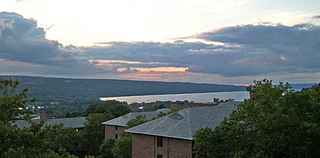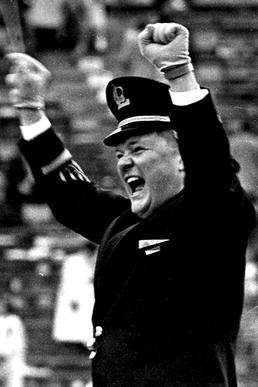A fight song is a rousing short song associated with a sports team. The term is most common in the United States and Canada. In Australia, Mexico, and New Zealand, these songs are called the team anthem, team song, or games song. First associated with collegiate sports, fight songs are also used by secondary schools and in professional sports.

"O Tannenbaum", known in English as "O Christmas Tree", is a German Christmas song. Based on a traditional folk song which was unrelated to Christmas, it became associated with the traditional Christmas tree.

"Far Above Cayuga's Waters" is Cornell University's alma mater. The lyrics were written circa 1870 by roommates Archibald Croswell Weeks, and Wilmot Moses Smith, and set to the tune of "Annie Lisle", a popular 1857 ballad by H. S. Thompson about a heroine dying of tuberculosis.

"The Victors" is the fight song of the University of Michigan. Michigan student Louis Elbel wrote the song in 1898 after the football team's victory over the University of Chicago, which clinched an undefeated season and the Western Conference championship.

"Annie Lisle" is an 1857 ballad by Boston, Massachusetts songwriter H. S. Thompson, first published by Moulton & Clark of Newburyport, Massachusetts, and later by Oliver Ditson & Co. It is about the death of a young maiden, by what some have speculated to be tuberculosis. However, the lyric does not explicitly mention tuberculosis, or "consumption" as it was called then. The song might have slipped into obscurity had the tune not been adopted by countless colleges, universities, and high schools worldwide as their respective alma mater songs.
"Victory for MSU", formerly "MSU Fight Song", is the official fight song of Michigan State University. It was created in early 1915, when MSU was known as Michigan Agricultural College (M.A.C.). An MSU cheerleader, Francis Irving Lankey, along with lyricist Arthur Sayles, created the song. With several changes noted below, the school has used the same song ever since. The MSU Fight Song is played at all university sporting events and is frequently sung by students and alumni.

The Michigan Marching Band is the official marching band of the University of Michigan. The band performs at all Michigan Wolverines football home games, select away games, and numerous concerts, pep rallies, and parades. As a student musical ensemble, the MMB evolved from the original Michigan Band of twenty-two players in 1896 to today's band of over 400 members.

"Carmen Ohio" is the oldest school song still used by Ohio State University. The song was composed by freshman athlete and Men's Glee Club member Fred Cornell in 1902 or 1903. According to some accounts, he composed it on the train ride home from Ann Arbor, Michigan after Ohio State suffered an 86-0 loss to the Michigan Wolverines. The song is set to the tune of "Spanish Hymn", or "Spanish Chant". The Men's Glee Club first performed it in 1903; however, it did not gain popularity until after its publication in The Lantern on October 10, 1906. At the following Ohio State–Michigan football game on October 20, 1906, "Carmen Ohio" was published in the program. In 1915, Cornell recalled that he wrote the song in 1903 at the request of the Men's Glee Club, and other family members later stated that the train story might be an exaggeration or outright fabrication. Currently, after every home football game in Ohio Stadium, win or lose, the football team and the crowd sing the first verse of Carmen Ohio, accompanied by The Ohio State University Marching Band. It is also sung by new graduates at the end of the university's commencement ceremonies, after diplomas are distributed.

"On the Banks of the Old Raritan" is a song, or alma mater, associated with Rutgers, The State University of New Jersey, in the United States. The original lyrics were written in 1873 by Howard Newton Fuller, an 1874 graduate of Rutgers College. Fuller quickly prepared the song as a school hymn for the college's Glee Club, an all-male choral ensemble, before a performance in Metuchen, New Jersey. Fuller chose to set the lyrics to the tune of melody, "On the Banks of the Old Dundee", a popular Scottish melody regarded as a drinking song, and titled the song for the Raritan River.

The "Penn State Alma Mater" is the official alma mater of The Pennsylvania State University. The song was accepted by the university in 1901.
"The Red and Blue" is a popular song of the University of Pennsylvania, a private Ivy League university in Philadelphia.
Brown University traditions hold that two songs, "Alma Mater" and "Ever True to Brown", are sung at public events and gatherings related to the university. The traditional alma mater song, "Old Brown," was created in 1860 and "Ever True to Brown", the second school fight song, was written by Donald Jackson. The song is played by the Brown Band at major varsity athletic events and at formal events such as Convocation and Commencement. An unofficial version offers humorous alternative lyrics.

Thomas Tyra was an American composer, arranger, bandmaster, and music educator.

"Hail to Pitt" is the most traditional fight song of the University of Pittsburgh, which is commonly referred to as Pitt. The saying "Hail to Pitt!" is also the most traditional and commonly used slogan of the University of Pittsburgh and its athletics teams. The slogan is frequently used in promotional material, printed on merchandise and souvenirs. It was also the title of a 1982 history of Pitt athletics by author Jim O'Brien. The slogan is often used among alumni as a statement of affiliation, including as a closing signature in conversation or correspondence between alumni, and is sometime abbreviated as "HTP" or "H2P", the latter of which is a registered trademark of the university and is frequently used on official university signage and merchandise.

"Hark the Sound" is the alma mater (song) of the University of North Carolina. It was written by William Starr Myers, a member of the UNC Glee Club at the time. It is sung at the end of athletic events and other university gatherings, and is one of many alma maters set to the music of "Annie Lisle".

Charles Mills Gayley was a professor of English, the Classics, and Academic Dean of the University of California at Berkeley between the fall of 1889 and July 1932.

The History of Michigan Wolverines football in the early years covers the history of the University of Michigan Wolverines football program from its formation in the 1870s through the hiring of Fielding H. Yost prior to the 1901 season. Michigan was independent of any conference until 1896 when it became one of the founding members of the Western Conference. The team played its home games at the Washtenaw County Fairgrounds from 1883 to 1892 and then at Regents Field starting in 1893.
"Let's Go Blue" is a short song most often associated with the University of Michigan, but widely performed during high school and professional sports as well. It was composed by Joe Carl and first arranged by Albert Ahronheim in the 1970s. The song consists of 32 bars and is 40 seconds long.
J. Fred Lawton was a lyricist, poet, and businessman active in the greater Detroit area who was closely associated with the University of Michigan for most of his life.

"Varsity" is a fight song of the University of Michigan.













